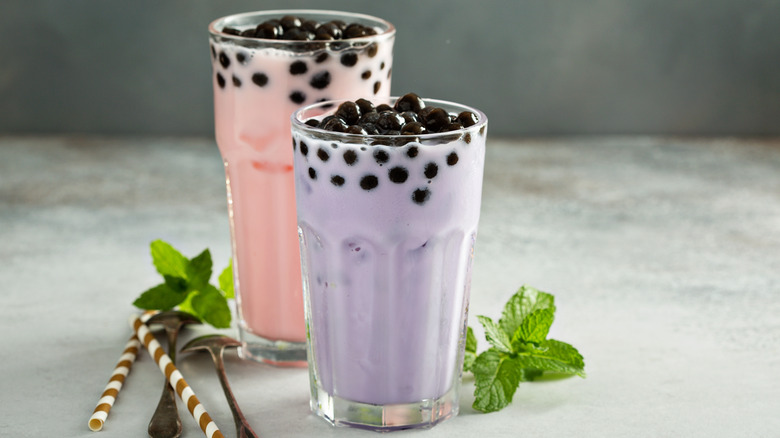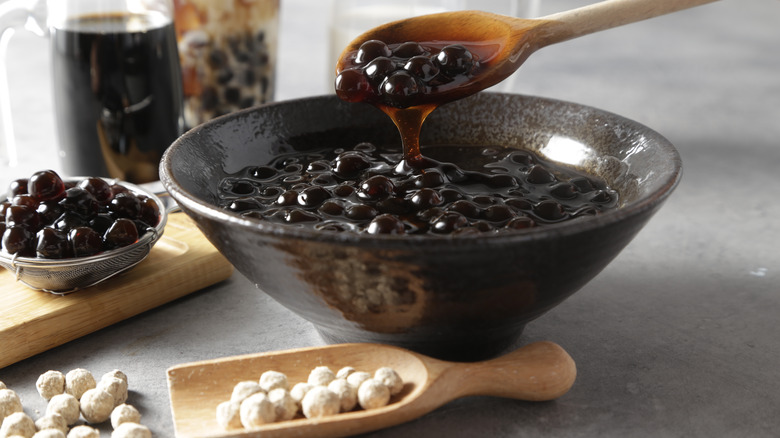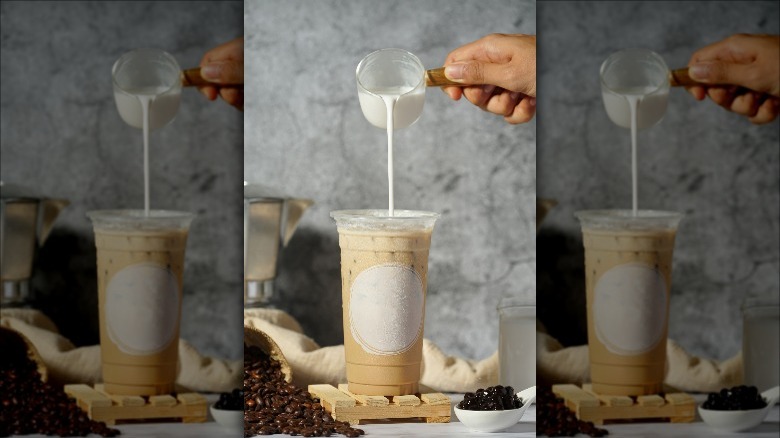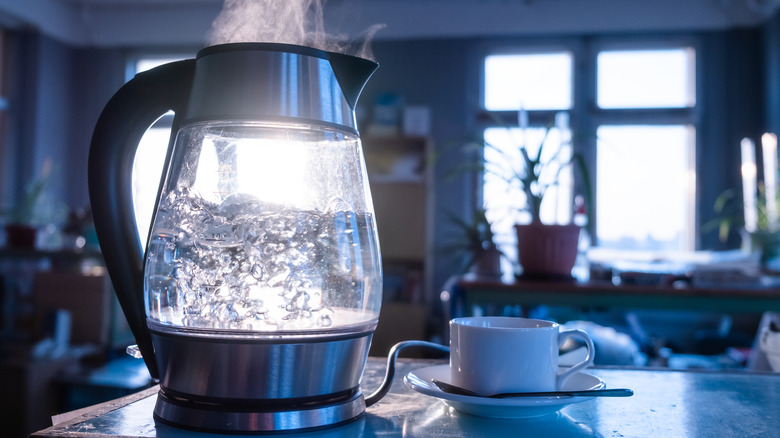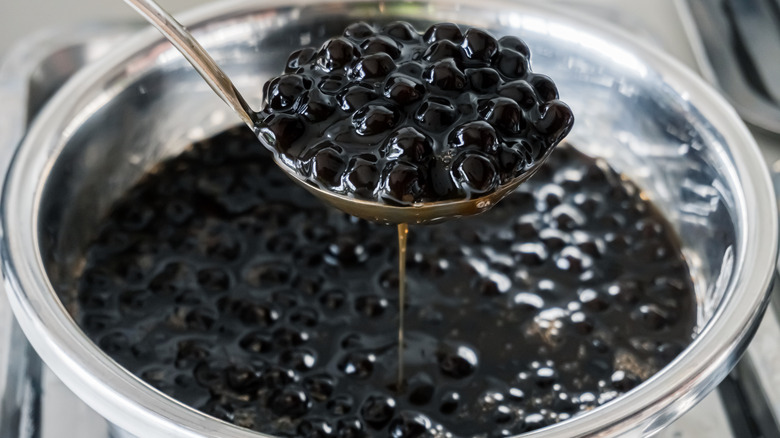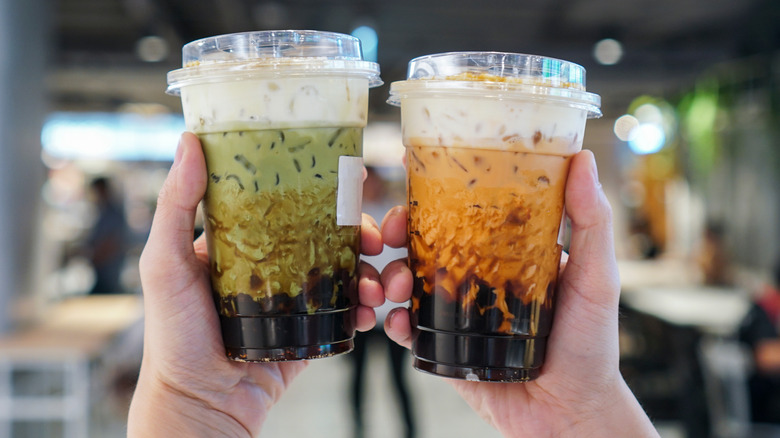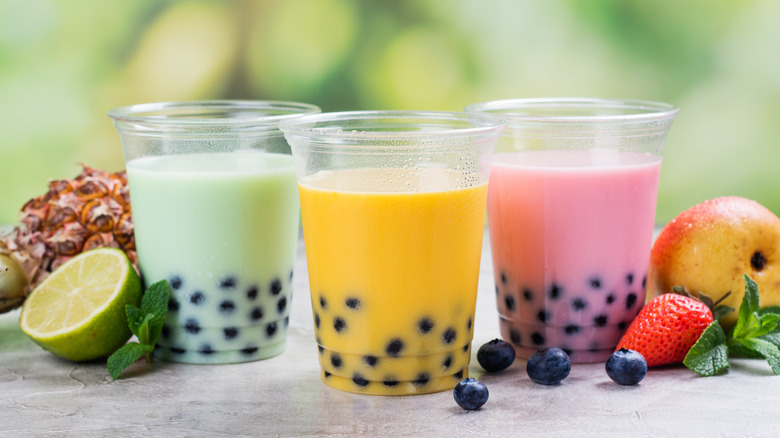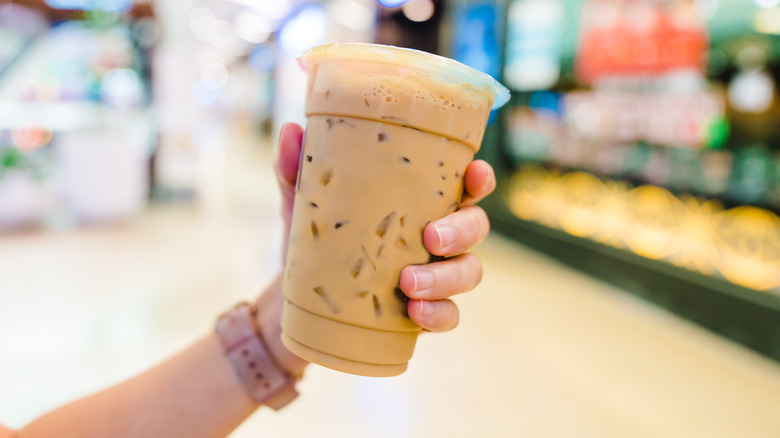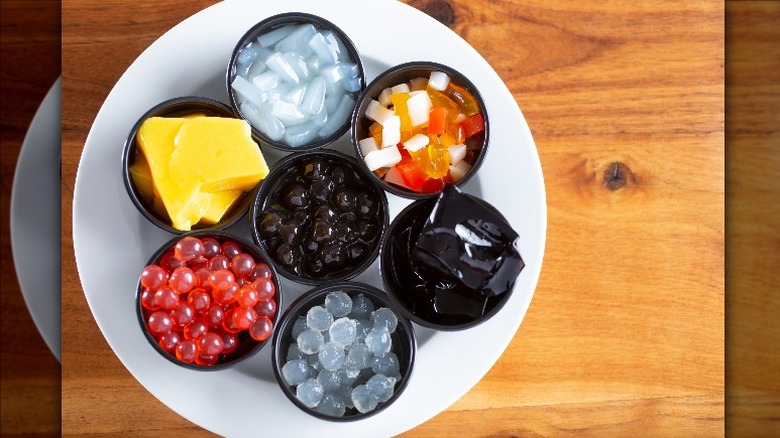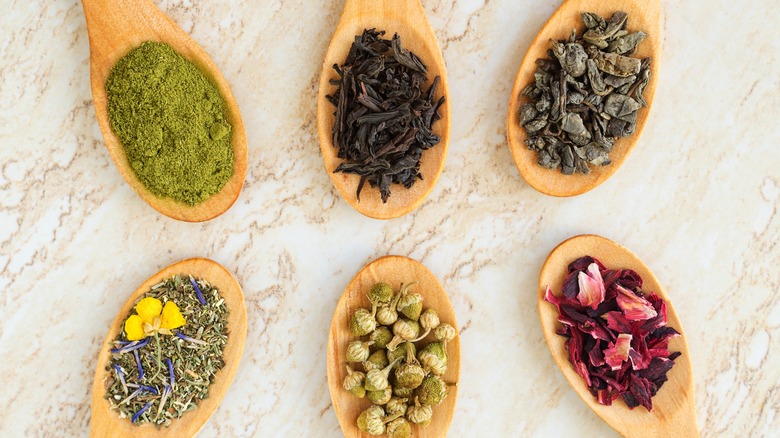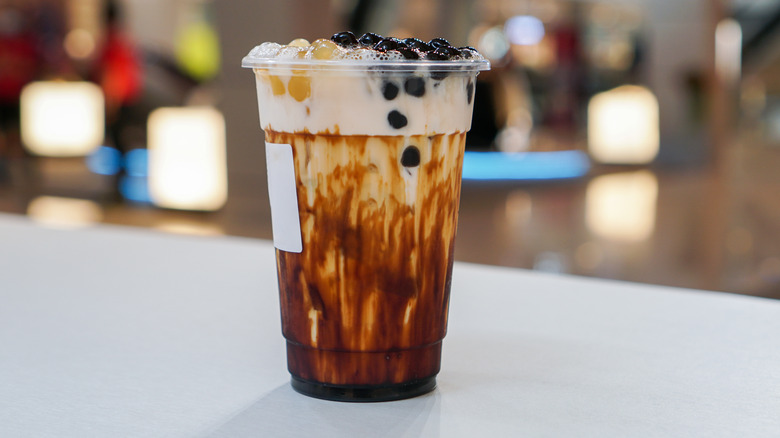10 Golden Tips For Making Your Own Boba
From New York City to London Town, Singapore to Seoul, bubble tea shops adorn streets the world over. Originating in Taiwan in the 1980s, bubble tea was created by Liu Han-Chief and Lin Hsiu Hui when the latter decided to turn her tapioca pudding into a drink at a business meeting, per CNN. "It quickly outsold all of our other iced teas within a couple of months — even after 20 years on the menu, bubble tea makes up 80-90% of our sales and Taiwanese are proud of this home-grown drink," Hui told the outlet.
Indeed, the bubble tea craze has been showing no signs of slowing. Nothing can really compare to that unique mix of tea leaves, syrup, frothy foam, and, of course, those scrumptious tapioca pearls. The beverage is sweet and comforting, the perfect non-alcoholic drink for socializing Millennials and Gen-Zers. As The Guardian points out, boba also marks a fun alternative to mainstream café offerings. Sure, a Starbucks Iced Passion Tango Tea Lemonade sounds awesome, but have you ever tried a tiger milk brown sugar popping boba tea?
While stepping out to your favorite bubble tea establishment during your lunch break makes for fabulous refreshment, you can also create this yummy beverage at home. Though making your own boba may appear daunting at first, the process is surprisingly straightforward — if you commit yourself to these essential steps. So, if you're on the bubble about making your own boba, follow these golden tips for a tasty tea.
Make sure pearls are fresh and flavorful
Part of what makes boba so popular and distinct from the milkshakes and lattes available in strip malls is the tapioca pearls. There's nothing quite like slurping up those delights at the bottom of the cup, making boba feel like both a drink and a tasty snack. But one false move and those delicious, chewy pearls can become a stale, gelatinous mess. So when you decide to make your own boba, be sure to perfect your pearls like a boss.
As The Seattle Times explains, you can figure out whether your tapioca is high quality based on its elasticity. Accordingly, the main thing to avoid when making boba from scratch is ending up with a heap of hard, unappetizing pearls. And how can you spot the springy from the sturdy? "The BEST cup of boba will have a warm bottom, as it means that they've very recently cooked the tapioca to perfection," boba fan Corinne Chin told the outlet.
You'll need three main ingredients to make the pearls: tapioca flour, which is used to thicken the texture, water, and sugar (opt for brown for extra flavor). You can even throw in some food coloring, though this isn't a requirement, per The Washington Post. To get the right consistency without skimping on taste, it's imperative you make your drench your boba in its quintessential sugary syrup (consisting of sugar and water). Or, for an experimental flavorful kick, try soaking it in dark rum.
Ditch the powder for fresh milk
Many bubble tea stores use a powder and water mix for milk tea drinks. LimeRed Tea House notes that stores often use powdered substitutes because they're cheap and shelf-stable. But experts warn that doing so will hinder the flavor, making your boba have a rather cheap and inauthentic quality to it. It's best to use fresh milk when making bubble tea at home.
As Nicholas Phan, founder of Biju Bubble Tea, explains in The Guardian, powdered milk became ubiquitous across bubble tea stores from Singapore to the U.K. in the early 2010s. "The shops claimed to be tea specialists, but the tea they used was never freshly made," Phan recalled. "Instead it was made in vast quantities and reheated, either in kettles or with steam wands. Anyone who drinks tea will tell you that is no way to treat it!"
So when making your milk tea at home, keep that powder away and flock to the local farmer's market for fresh milk. Not only will using fresh milk give your boba an artisanal quality, but the taste will be far superior to cheap powders simply mixed with water, per Eater Los Angeles. And for those who don't consume dairy, fear not: Bubble tea works just as well with plant-based alternatives. For an extra creamy milk tea that's a dead ringer for the dairy variety, Vegetarian Times suggests using a combo of both almond and coconut milk.
Temperature is key to delicious bubble tea
Perfecting bubble tea is a fine art. Just one slight slip-up can ruin your boba, and nowhere is this more apparent than when it comes to temperature. "There are so many factors that can alter or change the texture of boba," boba businessman Jack Hsiao told Eater Los Angeles. "The flour mix for the boba, the cooking temperature, the holding time, and the water-to-boba ratio are all important factors... Boba hardens when cooking with too little water, cooking too fast."
Patience is key to getting that signature chewy bounce of the tapioca, per The Washington Post. There's a fine line between stale, hard pearls and tapioca that turns to mush. Therefore, you better act fast when dropping your tapioca into the saucepan — and make sure they're placed in boiling water, never cold. "If you put them in cold water, they will melt," boba chef Diana Shen explained.
Moreover, it's paramount that boba never be overcooked: think of it like baking your best batch of cookies — overcooking that dough is going to leave the finished product tasting more like crispy potato chips than a sweet treat. The same applies to cooking boba. Accordingly, BBC GoodFood recommends stirring the tapioca in 500 milliliters of boiling water for a couple of minutes. Ensure that you keep stirring the pearls so they don't stick to the saucepan. If bubbles begin to form, that's how you'll know that you're on the right track to perfect boba.
Never refrigerate your boba for long
Every boba lover has been there: Faced with an unquenchable thirst for your favorite drink, maybe you ordered more than you can chew, only to be left with a heap of bubble tea that's too good to throw out. Or perhaps your fave store had a two-for-one deal that you were powerless to resist. Unable to consume several helpings of the yummy treat, you stash it away in the refrigerator. When looking forward to consuming the leftovers the following day, you channel "Steamed Hams," declaring, "Egads! My boba is ruined!" Yep, when stored in the refrigerator, boba pearls become practically inedible. As BBC GoodFood advises, it's crucial to drink boba fresh, as it hardens once coming into contact with the cold.
While the tea itself is fine to store in the fridge for a day or so, the pearls simply aren't made for a cold environment. According to FoodsGuy, refrigeration can turn pearls to mush: Ultimately, pearls will only retain the chewy taste that enthusiasts know and love for around six hours. Any longer, and they're a gross, soggy mess. The last thing any boba stan wants is a swarm of tapioca slush floating in tea.
So when cooking bubble tea at home, it's best to consume it within a few hours. To avoid any excess pearls, carefully measure out your ingredients, or better yet, invite some pals around for a popping boba party, ensuring nothing goes to waste.
Make it cheesy
Cheese tea? It turns out that boba cheese is the bee's knees. Up your bubble tea game by adding a generous helping of cheese into the mix. "The cheese neutralizes the bitterness of the tea with its smooth and sweet flavor," Xiao Shuqin, a publicist for a bubble tea store, told Vice, "and as you drink it you taste the returning sweetness of the tea." As Eater highlights, the main benefit of cheese tea is its savory edge. For those who find bubble tea too sickly sweet, this one is for you.
"We look for a cheese that isn't too sour or too salty, so we choose one with a lighter flavor," explains Zhou "Kiki" Meiqi, who manages a bubble tea store that specializes in the cheesy variety, per Great Big Story. Meiqi recommends blending the cheese with milk to make a thick and heavy topper that won't end up mixing with the tea; done right, the concoction should sit atop the drink.
Alternatively, swap milk for whipping cream when making cheese tea at home. Hanse suggests using dense cream cheese for the topping. Add some sugar and whipping cream and mix until you get a thick, creamy consistency. Once you've poured the tea into a glass, top it off with the cream cheese just like you would top hot cocoa with marshmallows. Unlike traditional bubble tea, cheese tea shouldn't be consumed through a straw, however. Instead, sip the drink to lap up that cheesy goodness.
Use real fruit for fruity boba
As with powdered milk, using fake fruit really isn't the way to go when preparing your own boba. Often, bubble tea is made with artificial fruit, per the Chicago Tribune. But using real fruit will immediately give your boba a higher quality taste than unnatural citrus flavorings. Orlando Sanpo, who manages a bubble tea store in Australia, explained to QSR Media Australia that as the boba trend continues, aficionados are becoming increasingly selective about the ingredients they want in their teas. "We want to keep our teas as natural as possible, which is why we do not add any sweeteners to our teas," Sanpo said, noting the importance of using "freshly cut seasonal fruits." According to Bubbleteaology, the great thing about fruit tea is that it bypasses the need for additional sugar or sweeteners. Moreover, fruit teas are particularly refreshing in the summer months.
Mango is a great option when making your own fruity bubble tea. The Guardian recommends using one fresh mango mixed with the juice of a couple of oranges for a real zesty kick. Ideally, you'll want to purchase your mangoes at the height of their season to make your fruit tea as delicious as can be, with April being the ideal month to snag the scrumptious alphonso mangoes of India. Alternatively, Honeysuckle suggests upping the ante with fresh watermelon for a truly unique boba experience. Just be sure to strain the watermelon pulp if you prefer a smoother tea.
Shaken not stirred
Contrary to popular belief, bubble tea does not derive its name from the yummy tapioca pearls that float at the bottom of the cup. Rather, the bubbles are in reference to the method of preparation, i.e. vigorous shaking. "It's freshly brewed tea with milk and sugar that's been shaken... that's where the term 'bubble tea' comes from," bubble tea store owner Nicholas Phan told BuzzFeed. "Shaking the tea gives it a bubble froth on top of the drink, and that's its namesake!" As any boba devotee knows, however, not all varieties of bubble tea have that frothy coating. Fruit tea, for instance, may or may not be frothy depending on where it's purchased from. But when it comes to making milk tea, failing to shake the ingredients is not an option, per Eater Los Angeles.
So, when you prepare your own milky boba recipe at home, it's imperative that you shake your mixture with all your might. There are various ways of attaining that perfect bubbly coating atop the beverage, For best results, boba should be mixed using a cocktail shaker, though you can also use a wide, tightly sealed jar, per Bubbleteaology.
Be sure to shake your concoction at the right time. As BBC GoodFood recommends, you can attain extra foaminess by adding your key ingredients into a shaker with ice and shaking for around six seconds. Once the shaking has concluded, you can pour your appetizing beverage and, finally, add the syrup.
Don't overdo the pearls — and try these toppings instead
Tapioca pearls are incredibly fun, and let's be honest, most boba lovers waiting at the store counter have been tempted to order double (or quadruple) tapioca at some point. It's best, however, that you resist tapioca temptation. In fact, adding too many pearls to your home mixture can be a recipe for disaster.
In 2019, a girl in China made headlines when 100 undigested tapioca balls were found in her stomach. As reported by the Chinese outlet The Paper, she was constipated for almost a week, with doctors finding her boba habit was responsible for the blockage. Dr. He Yuling warned that the starch in tapioca pearls is difficult to digest and thus excessive consumption may "easily lead to gastrointestinal dysfunction." Insider notes that tapioca itself isn't dangerous, but too much of it can certainly hurt your stomach lining.
So, as with any treat, be sure to throw those pearls into the mix in moderation. Alternatively, you can swap tapioca for fruit jellies or even aloe vera. For a fun — and certainly less starchy — spin on boba, Angel Wong's Kitchen suggests substituting coffee jelly for the tapioca. All you need for this recipe is instant coffee, sugar, gelatin, and boiling water. Once you've made your jelly, add it to milk tea and enjoy a refreshing, bouncy alternative to stodgy tapioca pearls. Just be sure to have a super thick straw at hand to slurp up those jellied delights.
Carefully select your tea base
There are so many bubble tea flavors on offer, so DIY boba enthusiasts are spoiled for choice. But whatever tea you use will drastically alter your mixture, so it's crucial that you pick the right tea for your homemade recipes. "We approach our teas like wine experts," boba inventor Lin Hsiu Hui told CNN. And like a fine wine, it's all about the subtleties of taste. For instance, an Assam base is going to taste vastly different from a green tea base and you better adjust the rest of your ingredients accordingly.
As Eater Los Angeles explains, opt for black tea if you need a caffeine kick, but choose green tea if you're making fruity boba. Meanwhile, oolong is great for the highly popular and gloriously purple taro milk tea. Additionally, Joshua Weissman suggests using Earl Grey paired with nut milk to make traditional milk tea hit differently.
And it may sound sacrilege, but sometimes it's best to add no tea at all. Although standard milk boba is traditionally made with black tea bags, you can actually skip the tea altogether for an even thicker concoction. According to BBC GoodFood, you can simply up the milk sans the tea for a super smooth, creamy experience. In lieu of tea, try using ingredients such as red bean or sour plum as a base, as writer and boba enthusiast Jiayang Fan recommends in a tea-spilling interview with NPR.
Brown sugar will make your boba pop
There's a reason why brown sugar remains one of the most popular boba flavors. Brown sugar is preferred in Taiwanese bubble tea stores because of its complex flavor, per Eater Los Angeles. In fact, fans of tiger milk boba, which is made with a heavy brown sugar syrup, once waited in line for hours in New York's Chinatown to snag the scrumptious concoction, per Food Insider. As Distraction Magazine explains, brown sugar is great for bubble tea devotees who crave an experimental and original alternative to tried and tested boba recipes. Unlike traditional bubble tea, which contains syrup and white sugar, brown sugar boba has a sweet and richly satisfying taste due to its caramelized brown syrup.
Part of what makes brown sugar tea so great is its darkening of the traditionally pale milk tea, making your beverage look more like a latte than boba, per Chao Coffee and Tea. Moreover, brown sugar helps to counteract the bitterness of the tea base due to its caramelized sweetness and rich aroma. And as previously mentioned, you can even ditch the tea entirely when making brown sugar boba. As Inga Lam highlights in her super sweet recipe, brown sugar bubble tea makes for the perfect candy-like treat. Simply combine brown sugar pearls with brown sugar syrup and add a hefty helping of milk for a tantalizing tasting experience minus the tea base.
